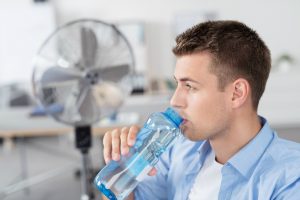Health and Safety Risks of Sun and Heat in the Workplace
 It looks like summer is finally on its way! With many of us enjoying a bit of the sunshine, the heat can cause problems when trying to work. In many jobs, heat stress is a problem all year round (bakeries, kitchens, foundries etc). During the hot summer months heat stress can be a problem for other workers too.
It looks like summer is finally on its way! With many of us enjoying a bit of the sunshine, the heat can cause problems when trying to work. In many jobs, heat stress is a problem all year round (bakeries, kitchens, foundries etc). During the hot summer months heat stress can be a problem for other workers too.
Heat stress occurs when the body’s means of regulating its internal temperature starts to fail. As well as air temperature, factors such as work rate, humidity and clothing worn whilst working may lead to stress.
Most outdoor workers, such as construction workers, gardeners and maintenance staff, will already know about the risks from direct exposure to the sun. The sun’s UV rays can lead to sunburn, heat stroke and increased risk of skin cancer.
The soaring temperatures can have serious consequences for those working indoors or outdoors. Heat exhaustion, caused by lack of fluids, can lead to nausea, weakness and light-headedness. If left untreated it can lead to fainting and even heat stroke. Heat stroke can be potentially life threatening condition where the body loses the ability to control its own temperature.
What are the effects of heat stress?
Heat stress can affect people in different ways and some people are more susceptible to it than others. Typical symptoms are:
- An inability to concentrate
- Muscle cramps
- Heat rash
- Fainting
- Severe thirst
- Heat exhaustion – fatigue, giddiness, nausea, headache
- Heat stroke – this is the most severe disorder and can result in death if not detected at an early stage
What can I do to combat heat stress?
People all react to the heat in different ways. Over time people will adapt to the hot conditions by sweating more, and changing their behaviour to try and cool down, such as removing clothing, drinking cold drinks, sitting in the shade, reducing their work rate. In many work conditions behavioural changes may not be possible.
There are some things that we can do to help ourselves:
- Drink plenty of fluids
- Eat frequently
- Wear sun screen and apply it regularly, especially if working outside
- At the first signs of heat exhaustion move to a cooler area
- Look out for colleagues and know the signs and symptoms of heat stress
What do employers need to consider when it comes to heat stress?
Where heat stress is a possibility, employers must carry out a risk assessment. Things to consider are:
- The work rate
- Working climate
- Employee clothing
As an employer you should talk to your employees and see if they are suffering from the early signs of heat stress.
How to reduce the risks of heat stress at work
- Control the temperature. Where possible use fans or air conditioning
- Review how the work is done. Can mechanical aids be used for physical work? Can people work together to reduce the workload and stress? Look at the time the job is done.
- Prevent dehydration – provide cool water in the workplace and encourage workers to drink it regularly.
- Provide Personal Protective Equipment – provide clothing which is made of breathable fabrics.
- Rest breaks – allow workers to have short rest breaks to reduce the work rate and exhaustion.
- Training – provide training for staff telling them about the risks of heat stress and symptoms to look out for.
For more information take a look at the HSE guidance on heat stress:
Need More Assistance with Managing Heat Related Health Issues in the Workplace?
If you need help ensuring that you are taking care of your employees during the hot weather, need to conduct a risk assessment or even need any other advice about health and safety contact our team today on 01666 503686 or alternatively fill out our contact form.




